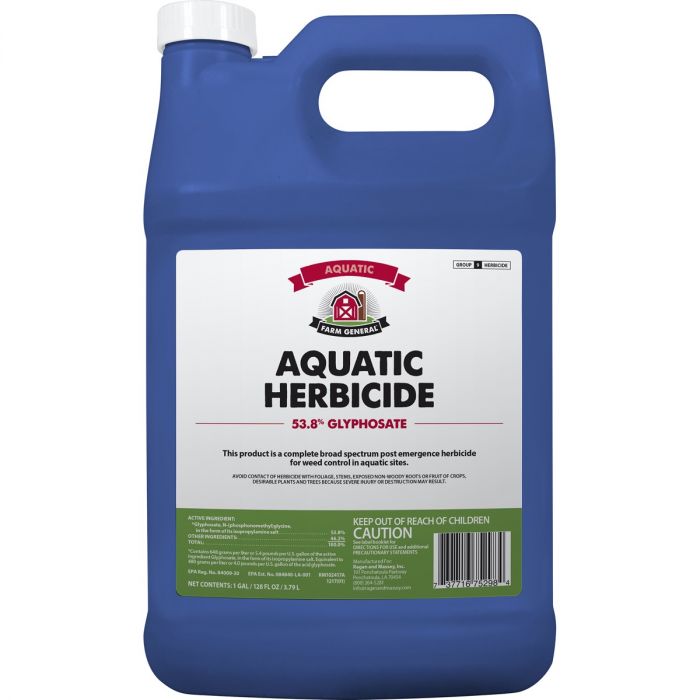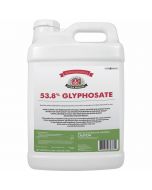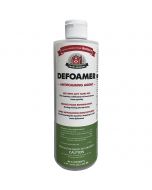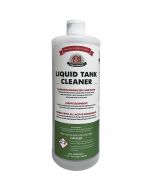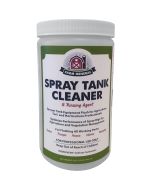Aquatic Herbicide
Farm General Aquatic Herbicide is a complete broad-spectrum post-emergence herbicide for weed control in aquatic sites. This product can be applied to emerged weeds in all bodies of fresh and brackish water which may be flowing, non-flowing or transient. This includes lakes, rivers, streams, ponds, estuaries, rice levees, seeps, irrigation and drainage ditches, canals, reservoirs and wastewater treatment facilities.
Serious weed control for aquatic sites.
Where to use:
Use to control weeds, woody brush and trees in aquatic sites including:
| Lakes | Ponds | Seeps | Reservoirs |
| Rivers | Estuaries | Streams | Rice levees |
| Irrigation and drainage ditches | Wastewater treatment facilities | Canals |
When to use:
Annual weeds are easiest to control when they are small. Best control of most perennial weeds is obtained when treatment is made at late growth stages approaching maturity. See the “WEEDS CONTROLLED” section of this label for specific weed rates.
Always use the higher product application rate in the specified range when weed growth is heavy or dense, or when weeds are growing in an undisturbed (non-cultivated) area.
Reduced weed control may result from treating weeds with disease or insect damage, weeds heavily covered with dust, or weeds under poor growing conditions.
For best results, spray coverage must be uniform and complete.
Do not spray foliage to the point of run-off.
How to use:
General Mixing Instructions
This product mixes readily with water. Mix spray solutions of this product as follows:
For hand-held or backpack sprayers (less than or equal to 5 gal. capacity):
Add the labeled amount of this product to the spray tank. Fill the spray tank with water and ensure thorough mixing. Alternatively, the labeled amount of this product can be mixed with water in a large container. Fill sprayer with the mixed solution.
For larger tank sprayers (greater than 5 gal. capacity):
Fill the mixing or spray tank one-half full with water and start agitation. Add the labeled amount of this product using a circular motion while pouring. Continue filling the spray tank with water and ensure thorough mixing.
Use caution to avoid siphoning back into the carrier source. Use approved anti-back siphoning devices where required by state or local regulations. During mixing and application, foaming of the spray solution may occur. To prevent or minimize foam, avoid the use of mechanical agitators, terminate bypass and return lines at the bottom of the tank and, if needed, use an approved anti-foam or defoaming agent.
Tank Mixing
Prepare the desired volume of spray solution by mixing the amount of this product in water as shown in the following table:
| Spray Solution | AMOUNT OF PRODUCT | |||||
| Desired Volume | 0.5% | 0.75% | 1.0% | 1.5% | 4.0% | 8.0% |
| 1 Gallon | 0.7 oz. | 1.0 oz. | 1.3 oz. | 2.0 oz. | 5.0 oz. | 10.0 oz. |
| 25 Gallons | 1.0 pt. | 1.5 pt. | 1.0 qt. | 1.5 qt. | 4.0 qt. | 2.0 gal. |
| 100 Gallons | 2.0 qt. | 3.0 qt. | 1.0 gal | 1.5 gal. | 4.0 gal. | 8.0 gal. |
2 tablespoons = 1 fluid ounce
Above percentages are on a weight-to-weight basis with water as 8.34 pounds/ gallon.
For use in knapsack sprayers, direct mix the appropriate amount of product with water in a larger container. Fill sprayer with the mixed solution.
Active Ingredients:
| Glyphosate, N-(phosphonomethyl)glycine, in the form of its isopropylamine salt* | 53.8% |
| Other Ingredients | 46.2% |
| Total: | 100.0% |
*Contains 648 grams per liter or 5.4 pounds per U.S. gallon of the active ingredient Glyphosate, in the form of its isopropylamine salt. Equivalent to 480 grams per liter or 4.0 pounds per U.S. gallon of the acid glyphosate.
Product Label:
Disclaimer:
It is a violation of Federal law to use this product in a manner inconsistent with its labeling. Read the entire label before each use. Use only according to label instructions.
See the complete label for specific use rates and detailed instructions.
Consult the Safety Data Sheet (SDS) for important safety information.

